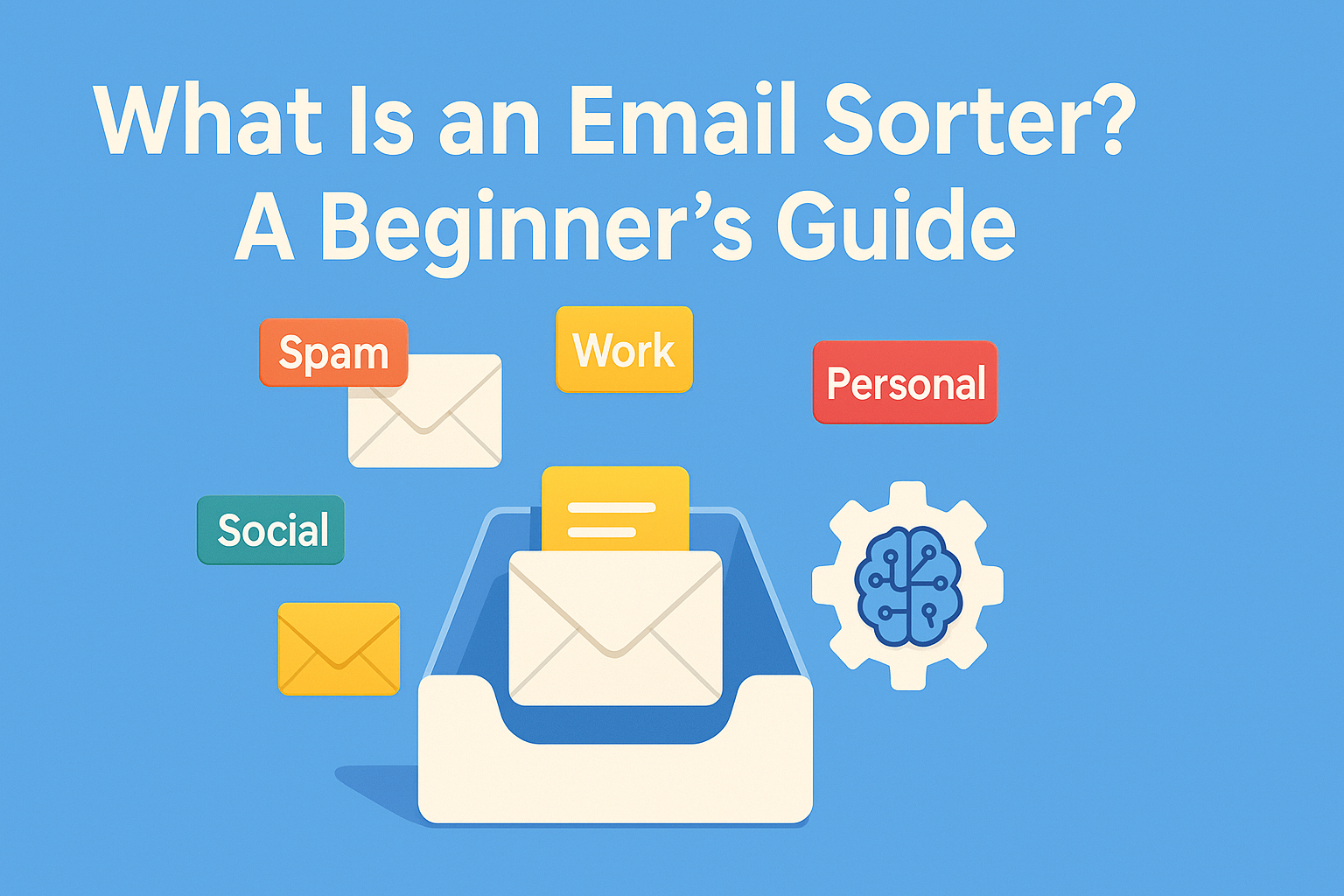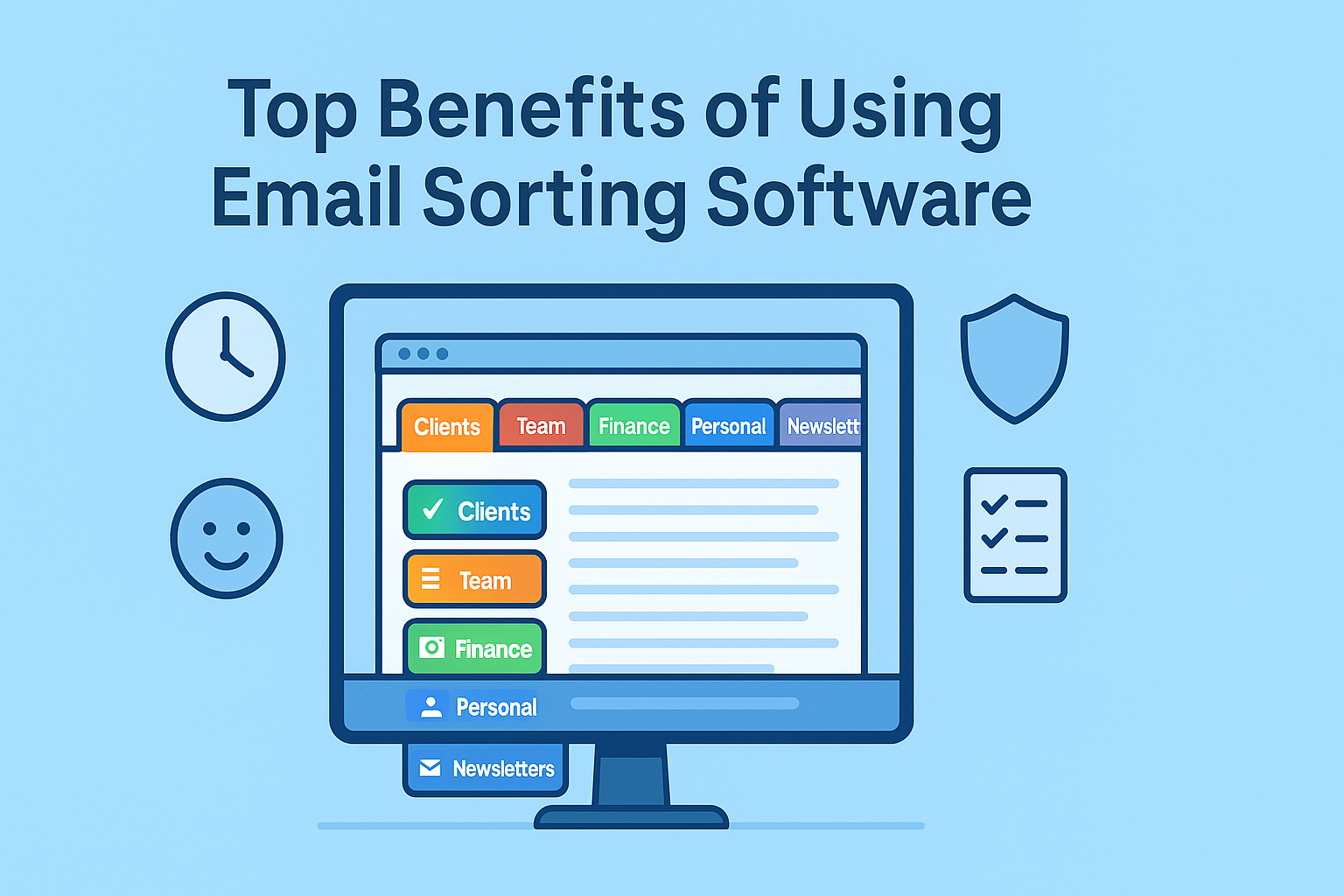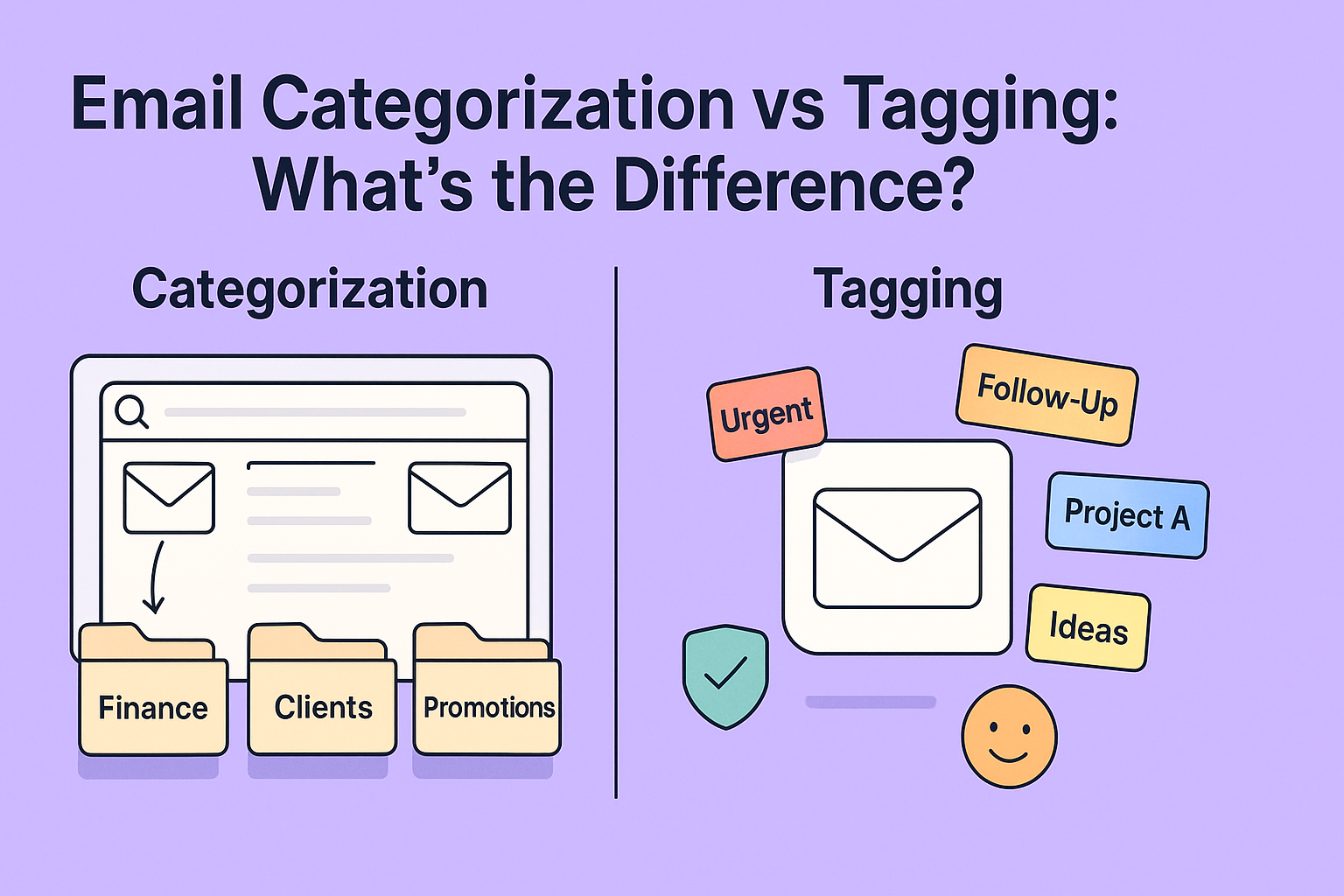Navigating data privacy in the EU means keeping up with one of the strictest privacy regulations in the world, GDPR. For professionals and organizations handling personal data, especially via email, ensuring compliance isn’t optional, it’s legally required.
As more teams turn to email sorting tools to manage daily communication and reduce information overload, the question arises: Can these tools be GDPR-compliant? The short answer is yes, but only if the tools are designed with compliance in mind. A careless or non-transparent setup could quickly put your organization at risk, from regulatory fines to loss of trust.
This guide breaks down what GDPR-compliant email sorting looks like, how to choose tools that respect privacy laws, and what steps EU-based users should take to align email automation with legal expectations.
What Are GDPR Basics
GDPR (General Data Protection Regulation) is a data privacy law in the EU. It gives people control over their personal data and sets rules for how businesses collect, store, and use that data. Key basics include getting clear consent, keeping data secure, allowing people to access or delete their data, and reporting data breaches quickly.
What GDPR Means for Email Communications
The General Data Protection Regulation (GDPR), introduced in 2018, set a new global benchmark for personal data protection. It gives individuals in the EU control over how their data is collected, processed, and stored—and it places strict responsibilities on any entity that handles this data.
When it comes to email, this means that anything containing personal details—from names and addresses to behavioral data and preferences—is protected. Organizations must ensure that any tools or systems processing this information meet GDPR’s legal criteria.
For email sorting specifically, the data being handled is often sensitive: client communications, contact details, and sometimes even health or legal information. Whether you’re manually sorting or using automation, the principle remains the same—processing must be lawful, fair, and transparent.
The Role of Data Processors and Controllers
Understanding the distinction between data controllers and data processors is crucial in GDPR compliance:
- Data Controller: The person or organization that determines the purposes and means of processing personal data. In most email contexts, this is you or your company.
- Data Processor: The service or tool that processes the data on your behalf—such as an email sorting tool.
When you use a third-party email sorter, you’re entrusting that tool with a processing role. Under GDPR, it’s your responsibility as the controller to ensure that the processor (the tool) complies with GDPR standards. That includes ensuring contracts are in place, rights are respected, and personal data is protected.
How Email Sorting Tools Fit into GDPR
Email sorting tools fit into GDPR by needing to handle personal data securely and only for clear purposes. They must protect user emails with proper encryption and privacy controls. If these tools process personal data, they should also allow users to access, correct, or delete their data and ensure they don’t share it without consent.
What Makes a Tool GDPR-Compliant?
A GDPR-compliant email sorting tool doesn’t just offer privacy settings—it builds compliance into the core of its design. This includes:
- Transparency: The tool clearly explains how it accesses and processes data.
- Security: It uses industry-standard encryption and limits data exposure.
- Control: You, as the user, can view, export, or delete data as needed.
- Consent Management: If a tool accesses personal information, it must offer mechanisms for ensuring that data subjects have given informed consent (if required).
It’s not enough for a tool to claim it’s “GDPR-ready.” You need to confirm it adheres to the regulation’s principles in practice—not just in marketing.
Common Misconceptions About Automation and Compliance
One common myth is that automated tools are inherently non-compliant. That’s not true. GDPR doesn’t ban automation—it regulates it. As long as automation follows transparent processes, includes human oversight where needed, and doesn’t expose personal data to unnecessary risks, it can be fully compliant.
Problems arise when tools process data outside of agreed terms or collect more data than necessary. For example, an email sorter that mines email content to build behavioral profiles without explicit consent would violate GDPR. On the other hand, a tool that simply sorts incoming messages by sender or subject, without storing or analyzing them inappropriately, is generally safe.
To better understand the boundaries, take a look at our article on email sorting safety, where we explore these concerns in more detail.
Choosing a GDPR Email Sorter
When choosing a GDPR-compliant email sorter, look for tools that clearly state how they handle personal data, use strong encryption, and have privacy policies aligned with GDPR rules. They should offer features to let users access or delete their data and ensure data isn’t shared without consent. Picking a trusted provider helps keep your email management safe and lawful.
Key Features to Look For
If you’re based in the EU or handling the data of EU citizens, your first step is to choose a tool that offers built-in safeguards. Here are the features that matter most:
- Local Data Storage or EU-Based Servers: This ensures data doesn’t get transferred to jurisdictions with weaker protections.
- Clear Data Access Logs: Know exactly what the tool accessed and when.
- Export/Delete Functions: Make it easy to honor data requests from users.
- Minimal Data Collection: The tool only processes what’s necessary for sorting.
- DPA Availability: The tool should offer a Data Processing Agreement on request.
These features aren’t just “nice to haves”—they’re foundational. Tools that don’t provide them may not be worth the risk.
Certifications, Audits, and Privacy Practices
Many GDPR-compliant tools go beyond the minimum by submitting to third-party audits or obtaining certifications like ISO 27001. These credentials signal that the tool has undergone rigorous scrutiny.
Also look for tools that:
- Publish regular security updates
- Offer transparency reports
- Have in-house data protection officers
A company that invests in these areas takes compliance seriously. And that’s exactly what you want from a GDPR email sorter.
Security and Data Storage Under GDPR
Under GDPR, security and data storage must protect personal data from loss, theft, or misuse. This means using strong encryption, secure servers, and access controls. Data should only be stored as long as needed for its purpose, and users must be informed about where and how their data is stored. Breaches must be reported quickly to stay compliant.
Where and How Email Data Is Stored
Data residency matters under GDPR. If your email sorter sends your data outside the EU (especially to countries without adequate protection), it must follow strict transfer protocols. That might include Standard Contractual Clauses (SCCs), Binding Corporate Rules (BCRs), or proof of adequacy decisions.
The safest option is to use a tool that stores and processes data within the EU. This minimizes transfer risk and ensures the provider is subject to GDPR enforcement.
Also, ask whether the tool stores data temporarily (for sorting only) or long-term (for analysis or logs). Short-term, encrypted processing is generally safe. Long-term storage requires stricter controls and documentation.
How to Evaluate Email Sorting Safety
Evaluating safety isn’t just about looking at encryption or reading a privacy policy. It’s about judging how seriously a tool treats your data. Look at:
- What permissions it asks for
- Whether it shares data with third parties
- If it lets you configure access at a granular level
If the tool processes content, even for intelligent sorting, ask whether it’s anonymized, aggregated, or stored at all. AI tools are especially complex—read more about how to judge AI email sorter safety when considering machine learning-based sorting platforms.
Client-Focused Professions and GDPR
For client-focused professionals like lawyers, consultants, and healthcare providers, GDPR is crucial because they handle sensitive personal data daily. They must keep client information secure, get clear consent before using data, and ensure clients can access or delete their data when needed. Failing to follow GDPR can lead to heavy fines and loss of client trust.
GDPR for Legal, Financial, and Healthcare Sectors
Certain professions operate under stricter data privacy rules, even beyond the core GDPR framework. Lawyers, financial advisors, and healthcare providers routinely handle sensitive personal data, including legal case files, medical histories, or financial records. In these industries, the margin for error in email sorting and automation is especially slim.
For example, an attorney emailing confidential client data must ensure that no third-party tool processes or stores that email without explicit safeguards. Misclassification or improper access—even unintentional—can lead to serious legal and ethical consequences.
This is where secure, compliant sorting becomes essential. Email sorting tools must:
- Limit access strictly to the inbox data required for sorting
- Avoid scanning or analyzing content without permission
- Allow configuration so that certain folders (like client correspondence) are excluded from sorting
- Maintain secure audit trails
Tools designed with compliance in mind can make inbox management easier while upholding legal responsibilities. A great example is how email sorters for lawyers are being used to manage communication more efficiently while remaining fully compliant with GDPR.
If you’re working in a sensitive industry, choosing a GDPR-compliant sorting tool isn’t just smart—it’s non-negotiable.
CRM Integration with GDPR-Compliant Tools
Integrating your CRM with GDPR-compliant tools ensures client data is managed securely and legally. It allows you to store, process, and update personal data with clear consent records. These tools help track data access, manage deletion requests, and keep all client information safe, supporting your business’s compliance while maintaining trust.
Sorting Emails in CRMs Like Salesforce
CRM systems like Salesforce are deeply embedded in modern workflows. They hold not only customer contact info but also communication history, behavioral data, and internal notes. Integrating an email sorter with a CRM can dramatically improve efficiency—but it introduces additional compliance concerns.
When using email sorting tools in conjunction with a CRM, the data processing landscape expands. You now have multiple processors (the email tool and the CRM), each responsible for handling potentially sensitive information.
This setup requires:
- Clear documentation on how data is transferred and stored between platforms
- Synchronized data protection agreements with both the CRM and the email sorter
- Visibility and auditability of all sorted email data that enters the CRM
For teams using Salesforce, it’s important to use tools specifically designed for secure integration. Many are now tailored for GDPR-sensitive workflows and offer precise control over what gets imported, tagged, or filtered.
To explore these options, take a closer look at using email sorters with Salesforce, especially if your team is automating contact and lead management in regulated industries.
Syncing Email Sorters with Salesforce Platforms
A well-integrated setup lets you define which emails get sorted and synced to Salesforce based on specific criteria—such as sender, keyword, or urgency level. This gives your sales or support team a unified, compliant view of communication without manually copying emails.
Here’s what to check for when syncing:
- Granular control: Can you decide what to sync, and when?
- End-to-end encryption: Is the email securely transferred to Salesforce?
- Logging and rollback: Can you undo or trace sorting actions?
Done right, this kind of integration balances automation with responsibility. It enables teams to act fast—without putting customer privacy or compliance at risk.
Steps to Ensure GDPR Compliance with Email Sorting
When using email sorting tools, it’s important to follow GDPR rules to protect personal data and stay compliant. Here are key steps to ensure your email sorting stays safe and follows the law.
- Choose compliant tools – Use sorters that follow GDPR rules and have clear privacy policies.
- Get consent – Make sure you have permission to process personal data in emails.
- Use encryption – Protect emails during transfer and storage.
- Limit access – Only allow authorized people to view sorted emails.
- Keep records – Document how and why you process personal data.
- Allow data rights – Ensure users can access, correct, or delete their data if requested.
- Report breaches – Have a process to report any data breaches quickly.
Creating a Data Processing Agreement (DPA)
If you’re using a third-party tool to sort email on your behalf, you’re required by GDPR to have a written agreement in place—called a Data Processing Agreement (DPA). This document outlines:
- What data is processed
- Why it’s being processed
- How it’s secured
- What happens in the event of a breach
Most compliant email sorting tools offer a DPA template you can review and sign during onboarding. If they don’t—ask. If they refuse—that’s a red flag.
This agreement not only satisfies a legal requirement but also ensures that both you (the controller) and the tool (the processor) are aligned on responsibilities.
Don’t skip this step, even for “free” tools. Any processor that touches EU personal data must adhere to GDPR standards, and a DPA is the foundation for that relationship.
Best Practices for Consent and Transparency
Even though most internal business email doesn’t require individual consent under GDPR (thanks to legitimate interest clauses), transparency is still essential. If you’re sorting emails from clients, customers, or newsletter subscribers, you need to be upfront about how their data is handled.
Best practices include:
- Updating your privacy policy to reflect use of email sorting tools
- Offering opt-out options where applicable
- Making it easy for contacts to access or delete their data
- Avoiding sorting tools that repurpose data for advertising or analytics
Being transparent doesn’t just keep you compliant—it builds trust. Clients and customers feel more secure when they know you’re treating their data with the seriousness it deserves.
Avoiding Pitfalls and Non-Compliance Risks
To avoid pitfalls and non-compliance risks with GDPR, always use tools that handle data securely and have clear privacy policies. Get proper consent before processing personal data, and don’t collect more information than needed. Regularly review your data practices, keep security measures updated, and train your team on GDPR rules to prevent mistakes that could lead to fines or loss of trust.
Examples of Non-Compliant Email Practices
Mistakes with email data happen more often than you think. Some common violations under GDPR include:
- Using a tool that transfers personal data outside the EU without safeguards
- Storing personal email data without time limits or access controls
- Letting automated tools analyze message content for advertising purposes
- Failing to disclose the use of sorting tools in your privacy documentation
These aren’t hypothetical risks. Companies have been fined for far less—especially when data was processed by third parties without proper agreements or disclosure.
The best way to stay clear of issues is to keep everything documented. From permissions to retention timelines, having a paper trail shows regulators that you’re taking compliance seriously.
How to Correct or Prevent Data Breaches
If you discover that a tool you’ve used has mishandled data—or that a breach has occurred—don’t panic. Under GDPR, you’re required to report most data breaches within 72 hours. That timeline includes alerting your Data Protection Authority and, in some cases, affected users.
Prevention, of course, is always better. So make sure you:
- Choose tools with strong breach response policies
- Keep software up to date
- Regularly audit access permissions
- Monitor data flows between apps and services
When in doubt, consult your DPO or legal counsel. Fast, transparent action is often enough to avoid fines—so long as you’re honest and proactive.
Final Recommendations
Using an email sorter doesn’t have to be a privacy risk. With the right practices, tools, and documentation, you can enjoy all the benefits of automation while staying firmly within the bounds of GDPR.
To recap:
- Always vet tools for GDPR compliance before use
- Request and review a Data Processing Agreement
- Use tools with clear permission controls and transparent data handling
- Keep sensitive data localized to the EU whenever possible
- Stay proactive about auditing and breach prevention
The inbox doesn’t have to be a legal minefield. With a Zoho Mail GDPR-aware strategy, it becomes a secure, manageable channel for communication and productivity.
FAQs
Do I need user consent to use an email sorter under GDPR?
It depends. For internal emails or legitimate interest use cases, no. For processing marketing data or profiling, yes—consent is often required.
What if my sorting tool is based outside the EU?
Ensure it uses standard contractual clauses and offers GDPR-compliant terms. Avoid tools with unclear data residency policies.
How can I check if a tool is GDPR-compliant?
Look for a DPA, privacy policy disclosures, EU hosting options, and third-party audits.
Is it safe to use AI-based sorting tools under GDPR?
Yes, but only if they explain how data is processed and offer opt-outs or oversight mechanisms. Check our article on AI email sorter safety for deeper guidance.
Can GDPR tools still sort emails automatically without breaking rules?
Yes. Automation is allowed, as long as data is processed lawfully, transparently, and under control of the data controller.




